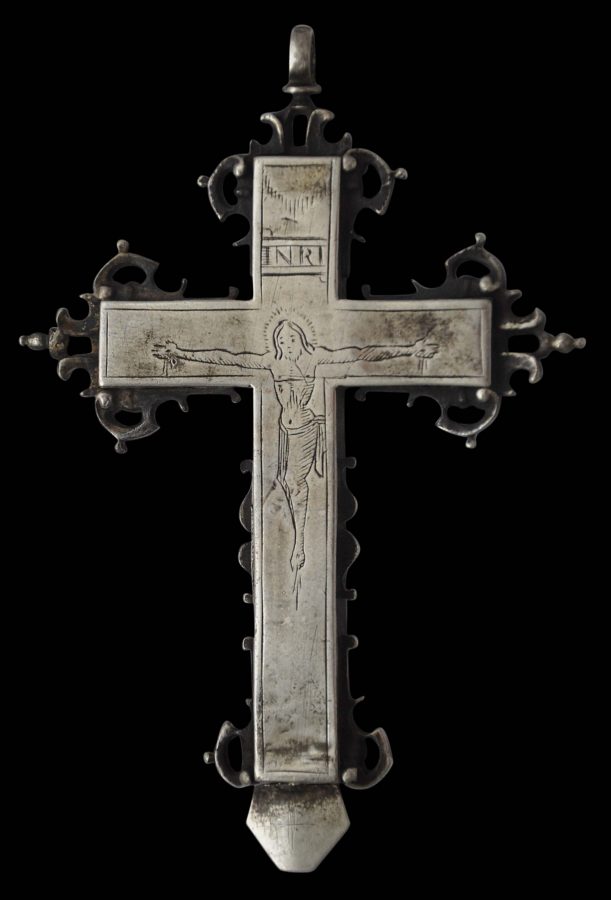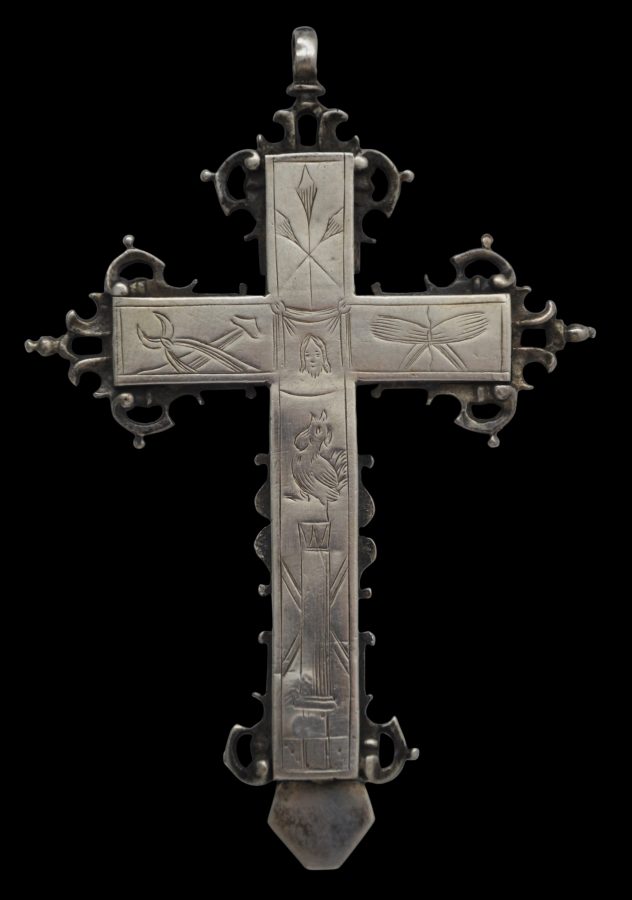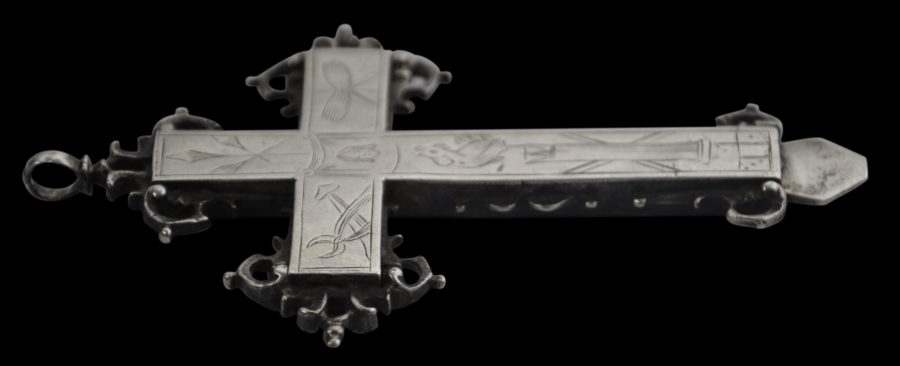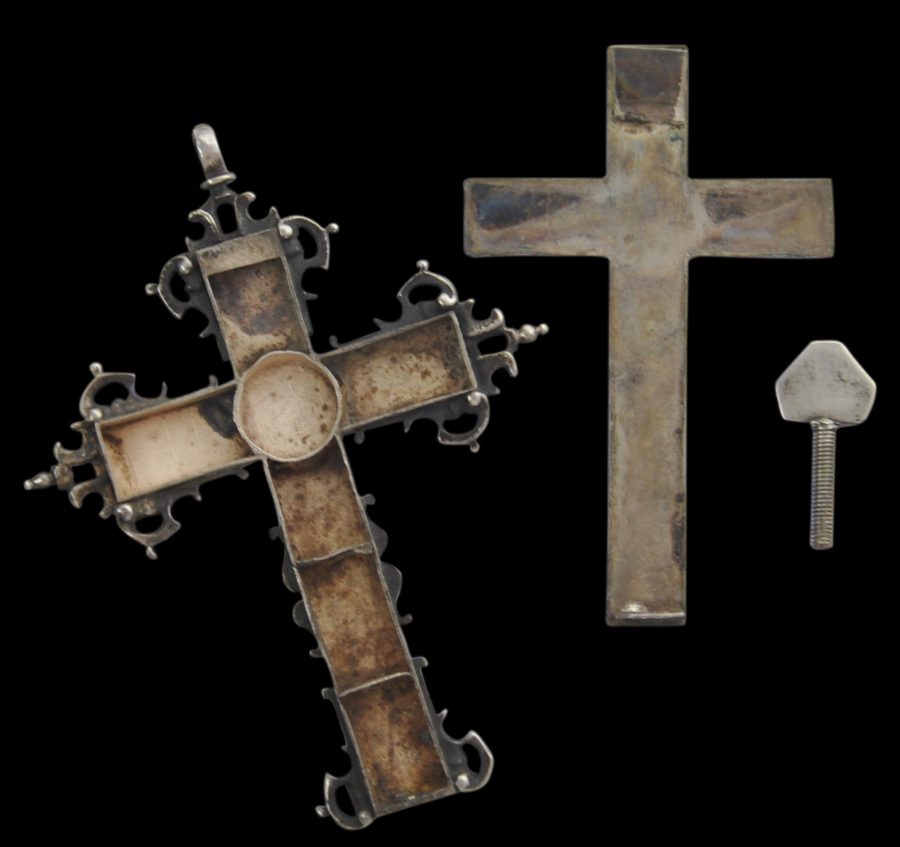Enquiry about object: 3785
Engraved Reliquary Silver Cross
Spain or Portugal 17th century
height: 9.4cm, with: 6.5cm, thickness: 0.7cm, weight: 26g
Provenance
UK art market
This elegant cross has been made in the shape of a budded Latin cross, possibly reflecting its intended contents: perhaps small pieces of what was believed to be treated as pieces of the True Cross or some other relics of an important saint. It dates to the 17th century and most probably is from the Iberian Peninsula or might be from colonial Spain or Portugal.
It is of solid silver sheet, and is hollow. There is a screw mechansim at its base which unscrews to allow one of the two faces to be lifted away to reveal an interior of seven separate compartments or chambers in which small relics would have been kept.
The edges and ends of the cross are decprated with applied silverwork and the top is also fitted with an eyelet to allow the Cross to be worn as a pendant.
Both sides are engraved. On one, the Crucifiction is depicted with Christ on the Cross. Blood strems from his wounds. The letters INRI which is the abbreviated form for the Latin ‘Iēsūs/Iēsus Nazarēnus, Rēx Iūdaeōrum’, or ‘Jesus, King of the Judeans’ have been engraved over the scene.
The reverse is engraved with various symbols, the main one of which is a rooster crowing on a column. This is a relatively rare, ancient Christian symbol not often used in Christian art. A rooster is said to have crowed three times after Peter denied Christ. As such, it became a symbol for Christ’s passion. Later, the rooster would signify Peter’s repentance. The motif of the rooster has carried through to modern times which is why weathervanes on churches and later on, any building, conventionally have weathervanes in the form of a rooster. The significance, of course, has largely been forgotten.
The column on which the rooster crows might also be symbolic of the column against which Christ was tied and whipped as part of his Passion.
Callisen (1939) cites mid-17th centuiry accounts of a now-lost statue of a bronze rooster atop a porphryry pillar at the Lateran, the traditional residence of the Popes until they moved to the Vatican. The author suggests that this image might have been a prototype for subsequent renderings, including perhaps the engraved image on the cross here.
Other symbols around the rooster and column are: the three nails used to crucify Christ (the belief or convention that just three nails was used is known as ‘Triclavianism’; the three nails insignia has become part of the symbol of the Jesuits); a pair of pliers or pincers used to removed the nails; the holy sponge set on a long reed (shown here behind the pliers) which was soaked in vinegar and offered to Christ whilst on the Cross to ease his suffering; the Veil of Veronica orSudarium, which is a cloth that Saint Veronica used to wipe Christ’s face as he carried the Cross, and which thereafter was imprinted with Christ’s face; and a sheaf of wheat, which has various meanings including being a symbol of self-sacrifice, fertility; the Resurrection; and of bread.
Wheat can also symbolise the Last Supper. ‘And as they did eat , Jesus took bread, and blessed and brake it, and gave to them, and said, Take, eat: this is my body. And he took the cup, and when he had given thanks, he gave it to them: and they all drank of it. And he said unto them, This is my blood of the new testament, which is shed for many.’ ( Mark 14:22-24).
The cross is stable and wearable. It has a fine, waxy patina and obvious significant age.
A related, though less elaborate example which is part of a rosary is in the British Museum.
References
Bagnoli, M., et al, (eds.), Treasures of Heaven: Saints, Relics and Devotion in Medieval Europe, The British Museum Press, 2010.
Callisen, S.A., ‘The iconography of the cock on the column’, in The Art Bulletin, XXI, 1939.





